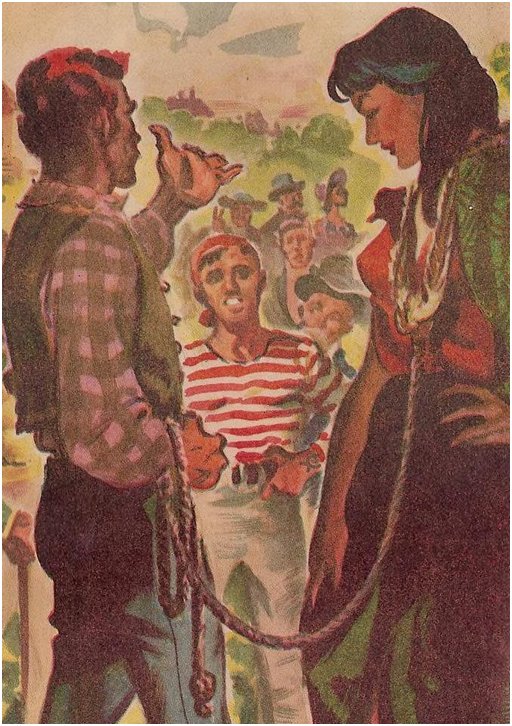Australian Wife Selling
This illustration of an humbled-looking wife with a heavy rope around her neck is from a two-page wife-selling spread in the June 1948 issue of Cavalcade magazine. Wife selling as a sort of informal divorce is a genuine historical practice, although this account in an ancient pulp magazine is no doubt heavily fictionalized. “I’ll bid four shillings, and if you’re a shrew, I’ll tame you…”
The associated story reads:
“Now what am I offered for this fine specimen of Currency womanhood? Born and bred in this country, she was. Twenty-eight years old and sound in tooth and limb. Look her over, men. Who’ll buy?”
There was a certain amount of excitement in old Sydney’s Rocks area when this announcement was made one fine summer’s day in December, 1825. A man named Martin Wheeler had placed a halter around the neck of his wife, Mary Wheeler, and had led her out into the street where he now offered her for sale to the highest bidder.
“But a man can’t sell his wife like that,” said one of the Sterling women recently arrived in the colony.
“Oh, yes he can,” she was told. “That’s the way he divorces her.” “Well, I’ve never heard the like,” the Sterling woman said.
“This is not England, you know,” a Currency lass told her. “This is New South Wales. In fact, it’s The Rocks. We do things differently hereabouts.”
“Now she’s a fine lass,” Martin Wheeler told his audience. “A bit sharp in the tongue, but if you’ll look at her, you’ll see other compensations.”
The men in the audience laughed and looked at the other compensations, which were obvious. Standing with the halter around her neck, Mary Wheeler returned their stares. She seemed a bold, likely lass for any man.
“I bid two dumps,” a wag in the crowd shouted, and there was more laughter. Mary Wheeler’s eyes flashed, and then she laughed with the crowd and said, “Mind you, let none of you men take me too cheaply,” and it was this show of wit that started the bidding in earnest.
“One shilling,” was bid by an old man.
“Come on, you can do better than that,” Martin Wheeler told him.
“I won’t be an old man’s darling,” cried Mary. She singled out a tall sailor from the crowd and addressed him, “You’ll bid two shillings, won’t you?” “I’ll bid four, and if you’re a shrew, I’ll tame you,” the sailor said, coming forward. He held the money in a fist the size of a young pumpkin. Mary Wheeler admired the fine tattooing on his arms, and the breadth of his chest. “Done, then,” said Martin Wheeler, taking the money and at the same time removing the halter from Mary’s neck. “Goodbye, Mary,” he said. “I’m a free man, and you’re a free woman.”
But the judge who some months later tried Mary Wheeler on a charge of bigamy did not take this same view of the matter. Mary’s plea that she had been divorced from her husband moved him not at all. It was necessary, the judge said, for people of the class the prisoner came from to understand that a man bringing his wife with a halter around her neck, and selling her, did not annul the marriage. For her bigamous marriage to the sailor, Mary Wheeler was sentenced to spend six months in a place of correction. As far as the records show, her husband Martin received no punishment. It was a man’s world in Sydney in 1826.
Elsewhere on Bondage Blog:


